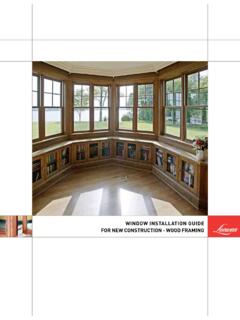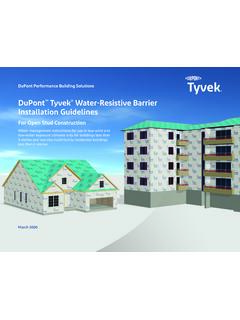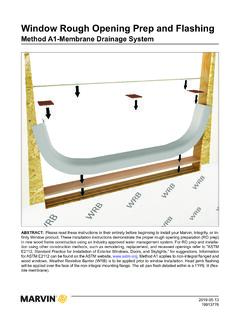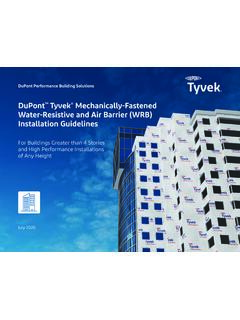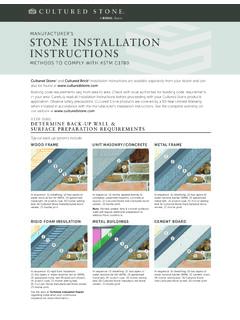Transcription of DOOR INSTALLATION GUIDE WOOD FRAMING
1 DOOR INSTALLATION GUIDE . WOOD FRAMING . IMPORTANT NOTICES AND INFORMATION. Read these instructions in their entirety prior to installing doors. Any local building code requirements supersede these recommended INSTALLATION instructions . Building design, construction methods, building materials and site conditions unique to your project may require an INSTALLATION method different from these instructions , and additional care. Remove shipping blocks and related staples prior to INSTALLATION . FOR TYPICAL WOOD FRAME CONSTRUCTION: These instructions were developed and tested for use with typical wood frame wall construction in a wall system designed to manage water, with a weather resistant barrier applied prior to the door INSTALLATION . These instructions are not to be used with other construction methods. PRECAUTIONS AND SAFETY: Do not work alone.
2 It is recommended that at least two people work together to avoid personal injury or damage when working with doors. Use caution when handling glass. Broken or cracked glass can cause serious injury. Wear necessary protective gear (gloves, clothing, goggles, etc.). Secure tools, ladders or scaffolding. Follow equipment manufacturers' operation instructions , warnings and cautions. Secure and properly support the unit until completely fastened. MATERIALS REQUIRED TOOLS REQUIRED. High impact shims (Sloped, shim pack or Tape measure Horseshoe Shims by Glazelock or equal). Level 1 1/2" (38 mm) #8 screws (stainless steel). Square OSI TeQ Foam for interior cavity seal Hammer OSI TeQ Flash Self Adhered Flashing 100' rolls Stapler (minimum 6" width on sill and minimum 4" on jambs and head). Check your code requirements Screwdrivers International OSI TeQ Seal Sealant Scissors or utility knife Rigid and sloped quality sill.
3 Screw gun OSI TeQ Foam Applicator Caulk Gun J Roller 2. Canada and EXPLODED VIEW TO DEMONSTRATE SEQUENCE. FLANGED DOOR BRICKMOLD DOOR. 1. VERIFY THE ROUGH OPENING. Measure the rough opening and the door to (Loewen pic for step 1 determine that the size is correct. The rough to come from Jeff) opening is recommended to be no less than 3/4" (19 mm) larger than the door unit in width and height. Ensure that the rough opening is plumb, level and square, and that the walls in the opening are not twisted. a) Sill must be flat and level. b) Adequate header must be applied, check with engineering. 2. WRB SHOULD BE APPLIED AND FASTENED PER MANUFACTURERS instructions . STEPS ON HANDLING THE WRB REMOVAL AT THE OPENING. If WRB is applied then cut away with a complete box cut of the opening. NO WRB should be brought into the rough opening. Create a temporary flap at the head of the opening by cutting the WRB on a 45 degree angle.
4 Temporarily tape the flap up out of the 3. way to allow for door INSTALLATION and head flashings. Cut back and expose the sheathing at the side jambs by removing approximately 1 1/2" of WRB. This will create direct-contact seal to the sheathing. 3. PREPARE AND APPLY THE SILL PAN. STEP 3A: FIGURE 1. Pan flashing is used at the base of openings and designed to collect and drain water directly to the exterior or onto the weather resistive barrier. Pan options are (Rigid, Flexible or Combination Rigid/Flexible), Rigid Sill Pans are recommended to be used wherever possible. Rigid Sill Pans should be sloped outward with a minimum 2 end dam, 1/2 interior upturn leg and 2 exterior down turn leg. Apply Teq Flash along the face of the sill whenever possible. Before fastening the sill pan, apply three heavy 3/8 rounded bead of OSI Teq Seal onto the FIGURE 2.
5 Construction plate, one outboard, inboard and at the exterior down turned leg. Continue the sealant approx 6 up both jambs at each end. (figure 1 and side view of sill pan). Set the pan into the sealant and check for level. Secure the end dams with fasteners as required (figure 2). Seal the end dams with TeQ Seal, tool the end dams to the FRAMING as shown. (see figure 3). FIGURE 3. International STEP 3B: 4 SIDE VIEW OF SILL PAN. Critical to run a bead of OSI Teq Seal along the interior of the upturn leg of the pan, the sealant bead can be applied before or after the door unit is installed and must create a positive seal along the entire sill of the door. Run a discontinuous bead of OSI Teq Seal along Canada and the exterior of the door sill nosing 4. PREPARE THE DOOR FOR INSTALLATION . FLANGED DOOR. Apply 3/8" bead for bedding joint. On backside of flange or brickmold, (where the sealant will make contact with the wall it is being applied to) apply a healthy, plump 3/8".
6 Bead of OSI TeQ Seal on all 3 sides of flange/. brickmold. BRICKMOLD DOOR. 3/8" DIAMETER. BEAD OF SEALANT. 5. INSERT AND FASTEN THE DOOR. FLANGED DOOR FLANGED DOOR. Set the bottom of the door into the rigid sill pan, then tilt the top into position. Center the door between the sides of the opening allow clearance for shimming. Insert 1 1/2" (38 mm) #8 screw to the top corners, this will keep the unit from falling during shimming etc. BRICKMOLD DOOR. BRICKMOLD DOOR 5. Flash the opening jambs and head with OSI TeQ. Flash before the door is installed. Make sure the jambs stay straight on flange or brickmold applications while applying screws approx. 12" apart. It is permitted to use tack hammer and construction staples to secure OSI. TeQ Flash during inclement weather conditions. 6. APPLY SIDE SHIMS. Shim the unit at the jambs, ensuring that it is square, and that the jambs, head and sill must be level and straight.
7 Apply a 3 1/2" #8 screw through every hinge into the RO studs. The shims should be placed at every hinge and lock location. 7. FASTEN THE UNIT. FASTENER SCHEDULE FLANGED DOOR. After verification, proceed to secure the unit by applying 1 1/2" (38 mm) #8 screws approximately every 12" (300 mm) through the nailing flange starting within 8" (200 mm) of the corner. The screw should be centered in the hole and securely fastened. Do not over tighten. Apply screws on all three sides. In areas where impact glass is required or in high wind speed areas, install screws in all prepunched holes (6 1/2" max.). International Galvanized or stainless steel screws are recommended. FOR BRICKMOLD DOOR. Install fasteners through jamb area or brickmold, BRICKMOLD DOOR. pre-drill holes and countersink. 6. Canada and 8. IF FLANGED DOOR, INSTALL THE SELF ADHERED FLASHING.
8 Use 4"or 6" OSI TeQ Flash to run the height of the door and extend up the head of the door another 4"or 6" (depending on size of flashing used across the head). Install the self adhered flashing over the mounting flanges on the jambs. Install the self adhered flashing over the mounting flanges at the head. Use J roller to smooth out flashing, eliminating air bubbles. 9. INSTALL THE RECOMMENDED HEAD FLASHING. FIGURE 1 Appropriate rigid head flashing must be installed across the top of the unit. Secure the head flashing with appropriate fasteners. (see figure 1). Seal over fasteners with OSI TeQ Seal . (see figure 2). Note: This step is not necessary if your door unit has an integral drip cap. FIGURE 2. 7. 10. INSTALL ANOTHER PIECE OF TEQ FLASH AT THE HEAD. Cut a piece of 4" TeQ Flash to apply over the FLANGED DOOR INSTALL. upturned leg of the rigid head flash.
9 BRICKMOLD DOOR INSTALL. 11. FOLD DOWN TOP FLAP OF weather resistant BARRIER. FLANGED DOOR INSTALL. Remove the previously applied tape holding International the flap of the WRB at the head. Allow the flap to lay flat over the head flashing. Apply slices of OSI TeQ Flash over the diagonal cuts made in the WRB. Ensure that the entire cut is covered. 8. BRICKMOLD DOOR INSTALL. Canada and 12. INTERIOR SEAL. OSI TEQ FOAM APPLICATION. Using the OSI TeQ Foam Applicator and OSI. TeQ Foam , low pressure foam, carefully apply foam around the three sides. From the interior, insert the nozzle of the applicator into the rough opening, hold the tip of the nozzle 1" (25mm) back from the exterior nail flange and apply a minimum 2" (50mm). bead of foam into the rough opening on top and both sides. Check and re-check to make sure that the foam has made complete contact between the door It is critical to fill the exterior 2" of the and FRAMING to both surfaces.
10 If any voids, rough opening with low expansion foam. reapply OSI TeQ Foam.. The interior of the rough opening could Important: At this point, from the interior side, be filled with foam or fiber glass. check the sill pan and make sure any voids are sealed where the door and upturned leg meet. 13. SEAL THE EXTERIOR AT THE FACADE. Exterior Facade should allow for 3/8" void at the perimeter of the door frame. This will allow for backer rod and high quality sealant at this critical interface. OSI Quad is highly recommended. Apply backer rod in such a way to avoid puncturing backer rod. Punctured backer rod can off gas and cause sealant bubbling. Backer rod should be slightly larger than the 9. void and fit snug into the void. ADDENDUM: INSTALLATION INSTRUCTION. SILL SUPPORT SCREW FOR I/S FRENCH DOOR PRODUCTS. STEP 1. PREPARING THE UNIT FOR INSTALLATIONS.



